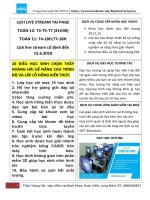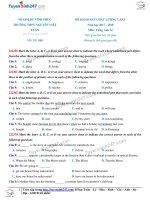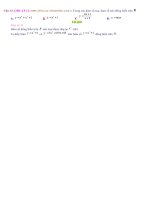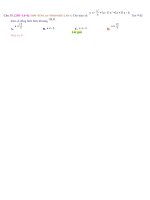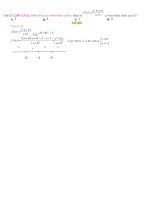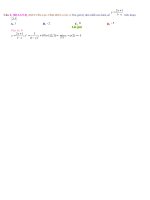Cs224W 2018 53
Bạn đang xem bản rút gọn của tài liệu. Xem và tải ngay bản đầy đủ của tài liệu tại đây (8.11 MB, 11 trang )
Money Moves the Pen:
Link Prediction in Congress Bill Co-Sponsorship Networks
Using Political Donor Network Information
Yi Zhong,
Eddie Chen,
December 9, 2018
Abstract
We combined the campaign contribution records
and congressional bill co-sponsorship data to
construct a tri-partite graph, in order to model
the money politics in the US Congress.
We
found that the US Congressional Politics is indeed a small world with collaboration resembling academic collaborations.
More importantly, we modeled the bill co-sponsorship prediction as a link prediction problem, using attributes learned from campaign contribution
networks.
Result shows that using campaign
networks is a good way to predict future inoffice collaboration between legislators, especially with a supervised, decision-tree model.
1
Introduction
Political collaboration is an important part of
legislative life, and congress bill cosponsorships
provide a rich source of information about the
social network between legislators [4], and serv-
ing as a proxy to understand legislators’ ” connectedness” and collaboration graph. Moreover,
according to Mark Twain, ”we have the best
government that money can buy” - money and
politics have already been intertwined. In this
project, we applied social network analysis tools
on political donation networks and congress bill
cosponsorship networks, and framed our research problem as a link prediction task on
congress bill cosponsorship networks using political campaign donation records for the US
(Congress and Presidential Campaigns) with its
network characteristics. We modeled and presented graph characteristics of the two political networks, and showed investigation results of
link prediction using various supervised learning
techniques for this project. We then compared
models’ performance to a naive baseline to come
up with evaluations.
2
Related
Work
While there is a substantial amount of literature
in studying the congress networks and the link
prediction problem, no prior work exists on combining congress bill sponsorship network with
campaign money networks and apply link prediction algorithms to the combined graph. Below, we review some of the state-of-the-art papers on this topic.
Fowler in his Connecting the Congress: A
Study of Cosponsorship
Networks
|4] mapped
the cosponsorship networks of all 280,000 pieces
of legislation proposed in the U.S. House and
Senate from 1973 to 2004, and reported out
several interesting statistics about the resulting networks. He further proposed a measure
of ”connectedness” by looking at the frequency
of cosponsorship and the number of cosponsors
on each bill to estimate the social ” distance”
between legislators, and used ” connectedness”
as a proxy for legislative influence. While the
paper has done an excellent exploration around
America’s political networks from an unique angle, it leaves more to be desired. He treated all
the links as unweighted in the paper; but as he
himself pointed out, some cosponsors are probably more important than others. Another downside of this paper is that it ignores the temporal
aspects of the co-sponsorship network. It only
looks at each Congress in this isolation without
change over time. Yet, given the dynamic nature
of bill writing and co-sponsoring, a study of how
co-sponsorship network forms and evolves (link
prediction) can reveal insight on how one can
work on being more connected and more influential in legislative outcomes.
Dominguez
[3]
examined
the
makeup
of
the Democratic and Republican party coalitions
by analyzing the contribution patterns of elite
donors (defined as all individual donors who
gave over $200 to one of the two major political party committees in the 2003-2004 election
cycle) and their network patterns. He showed
that both parties are similar in their degree of
centralization, with the party committees being
the most central actors in the network.
Both political donor networks
(in the form
of Super PACs) and Congress bill cosponsorships have been studied by students in CS224W
before.
In Co-Authorship Networks in
Congress [9], the authors looked at the impact
of co-sponsorship on legislation success. They
used the network characteristics to predict future co-sponsorship, via Supervised Random
Walks and Triads. While this past project
provided a lot good ideas, it lacked a discussion on using other machine learning models,
which can potentially yield good results, especially when the network is dense and Supervised
Random Walks
sparse graphs.
are known to perform well on
In Super-PAC
Donor
Networks
[7], the
author studied individual donors and their contributions to specifically Super PACs, a new
form of political action committees that can
raise unlimited sum of money for campaigns.
The authored looked at community structures
and other network characteristics for insights
on partisan polarization. The author did not
show how networks evolve over time, as donations might swing back and forth depending on
which party is in power, and the change in donor
demographics.
For Link Prediction, Liben-Nowell et al.
[6] discusses similarity based methods for link
prediction, and focuses on using network intrinsic traits to predict its future edge evolution. It explores a wide array of similarity measures (such as Common Neighbors, Jaccard’s Index, Adamic/Adar, and Katz clustering, etc.)
and compares their prediction accuracy among
themselves and against a random predictor as
baseline. However, the definition of node similarity is a nontrivial challenge, and it’s likely
that different networks would require different
definition of node ” proximity”. Moreover, a lot
of the similarity measures assume that the link
itself indicated similarity between two nodes,
which may or may not be true.
Al Hasan
et al.
[1] models the link pre-
diction problem as a supervised learning task,
identifies a set of proximity, aggregated, and
topological feartures, and applies common supervised algorithms like decision tree, SVM, kNN, etc. It evaluates these different models using metrics such as accuracy, recall, F-values,etc.
However, the paper skips entirely on hyperparameter fine-tuning for the model of choice
(SVM), likely because of the high accuracy it
was able to achieve with its well selected features. Moreover, the paper landed luckily on
a balanced data set with roughly equal numbers of positive and negative labels; yet for most
tight-knit communities that resemble a ”small
world”, labels are likely skewed, and we need to
pay close attention to data selection for training,
and probably considering techniques like downsampling.
Backstrom
et al [2] proposed
3. Compare features learned from graph
to candidate information: We ran models based on features learned from candidates’ campaign donation networks versus models based on candidates’ party
and home state information, to understand
what information is more predictive. We
compared the performance of this model
with two other models, a naive baseline
model using network density and a candidate only model using candidate attributes
only.
a new hy-
brid solution in tackling link prediction problem. It uses Random Walks with Restarts (basically Personalized PageRank with one node) as
a way to explore the network structure. It then
looks at the node and edge attribute data to bias
the random walk so that it will more often visit
nodes to which creates edges in the future, in
a direct and principled way and not to overfit.
Yet, the paper only considers node and edge attribute data, and posits that such intrinsic structure likely reflects exogenous characteristics as
well (in the Facebook friending example, ones
location/closeness in network to other people reflects the likelihood of people partying together
and therefore adding on Facebook together). Its
unclear to me if this holds true in political networks, especially in the Congress, when politicians come from vastly different places all over
the country and from different ideological allegiances as well.
The related work reviewed above provided
a lot great ideas, and the most obvious one
is perhaps to combine political donor network,
congress bill co-sponsorship network, and link
prediction together. Below, we present 3 creative contributions our project explored.
1. Model networks:
Both sections above
deal with bipartite graphs, and our subject
of study is a tripartitite graph consisting of
donors, politicians and bills. Unlike Fowler
[4], we modeled networks as undirected,
which is more compatible with existing link
prediction literature.
2. Incorporate edge weights in supervised learning models: Because our network of interest here carries a lot important information such as contribution
amount, We extended the abovementioned
work by incorporating edge weights.
3
3.1
Method
Problem
Statement
Our project is made up of two parts: graph modeling, and link prediction. For graph modeling,
we aim to construct a tripartite graph of political committees, legislators (we will ignore those
failed to get elected to office), and the bills those
legislators worked together on. A sample graph
can be found in Figure 1. With the graph constructed, we provide a set of statistics and descriptions of the graph structure (including their
one-mode projections, for both bills-legislators
and committees-legislators subgraphs).
After
that, we construct a link prediction problem by
dividing graph into different years of congress,
and select the suitable years for model training
and evaluation. Lastly, we report our learnings
from the entire exercise.
Practically, we hope our research can quantitatively answer the question: Does donation
in election affect collaboration in office?
Given a graph of congressional politicians and
their campaign donations, we want to predict
who will co-sponsor bills together as a form of
political collaboration. Here we focus on congressional bill (including all resolutions, bills,
and amendments) co-sponsorship because cosponsorship is an observable signal, and tells us
intuitively how much support one bill has and
Committees _ Politicians
oa
Congress Bills
2
Tỡ\
âđ
@
| =
eax (Es
(: ) E]
-2
'
â
(
"
â
-
m=
1981-2016 Data
_-=
_
TY
| =a=
=
=m
Figure 1: Illustration of the Congress Political
Network
therefore how much clout the politician behind
the bill has.
This problem has obvious utility: it would be
useful to keep the electorate informed of their
elected representatives’ political collaborations
and alliances in the Congress, as well as indicate any changes or tendencies in politicians’
stances on various issues. Moreover, for politicians, this information can be used as a guidance to seek more targeted co-sponsors, sparing
them from wasting precious political capital and
writing countless (and potentially spammy and
ineffective) ” Dear Colleagues” letters.
3.2.
In this project, we used the campaign financial
data provided by the Federal Election Commit-
tee! from 1981 to 2016 (the 97th to the 114th
Congress,
including
House,
Senate
and
Presi-
The bill co-authorship data is
obtained from the Government Publishing Of
fice’s website for the same period. 7. We have
hosted our code repository at https://github.
com/yzhong94/cs224w-project/.
A large part of effort to date has been devoted to data cleaning. In particular, we have
FEC
Website data:
dates not matched by the method above (capi-
talized full first name + last name + state abbreviation), and joined them together by capitalized full last name + state abbreviation, because people are very unlikely to have nicknames
for their last names. After that, we created an
Excel check function to alert us if we have one
NodeID (from the bill data) maps to multiple
different Candidate IDs (note: it’s possible for
a person to have two different Candidate IDs,
which happens when this person ran for House
first, then Senate later). We then manually in-
Data Preparation
dential races).
to join the campaign financial data, which uses
FEC’s Candidaite IDs, with the Congress bill
data, which uses its own ID system, on legislators. Our approach is to first join by legislator’s capitalized full first name + last name
+ state (abbreviation), which leaves out more
than 100 legislators not being matched between
the two datasets. A close examination reveals
that some legislators go by nicknames in signing bills but have full legal names on the campaign financial records - for instance, Tom Lewis
is actually Thomas Lewis, and James Cooper
going by Jim; this is made worse by irregular
nicknames too, such as Richard ”Doc” Hastings. Some legislators go by their middle names,
such as Raymond Eugene Green going by Gene
Green, David Adam Smith by Adam Smith. To
combat this, we first filtered out all the candi-
/>
advanced/?tab=bulk-data
https: //www.govinfo.gov/bulkdata/BILLS/115
spected the flagged rows and kicked out false
positives. In the end, we were able to find 1813
legislators/candidates from both the campaign
financial record and the bill co-sponsorship data
from 1981 to 2016.
3.3.
Network
Construction
We constructed a tripartite network: committees, legislators, bills. A committee can be a
PAC, SuperPAC or party committee. A legislator is an elected official in the Congress, which
can be a senator or a representative. A bill is a
draft of legislation that has been sponsored by
a legislator and co-sponsored by others. To de-
scribe the whole graph, we include all years of
data first (from 1981 to 2016), and then look at
one term’s data for an individual graph.
Between committees and legislators, an undirected link is added if a committee donates to a
legislator (we do not allow for multiple edges between two nodes). This way, we ended up having 1813 candidates with donations across the
years. We aggregated the donation amounts between candidates and committees by year and
preserved the sum as edge weights, to simplify
multi-edges. Between legislators and bills, an
undirected link is added first if candidates appear on the bill as either an author or a cosponsor.
3.4
Link
Prediction
After constructing the graph, we applied supervised learning link prediction on the bill cosponsorship part of the tripartitite graph, between politicians and bills.
Formally, let G(V,E) be our entire tripartitite graph with node set V and edge set
E, covering periods from tetar¢ to tena
to) be an arbitrary time period between
to
will
f¿„z
be
Our
training
{G,,,G:,}:
we
and
test
will train
graph
based
Let
tetart
pair
on
network
characteristics found in the subgraph
Ger"
to
(Viegislators;
Veommittees)s
and
use
that
{Gt
in Cấm 7
Viegistarors }
Viesislatores Voitts)
(which
where
is Viegisinters,n,)-
We
V
e Campaign only predictor: prediction model
using features generated from campaign
graph network attributes
3.4.1
Naive baseline predictor
We define our naive baseline predictor as follows:
given a pair of nodes v1, v2, we will always
predict there will be an edge between these two
pairs, i.e. as a complete graph. This is computed for Geo_sponsor-
That: is,
ACCUTOCY NaiveBuseline
=
EN
I[Y|l(IVll— 1)
Using the 100th Congress (1987 - 1988) as the
training set and the 101th Congress (1989-1990)
as the test set. The baseline accuracy is calculated as 96, 052/138, 075 = 0.695 per above.
3.4.2
Legislator only predictor
We define a second baseline using legislator attributes only. Features for link prediction
all come from information about the legislators. There are two features: IsFromSameState, IsFromSameParty.
Formally,
for
every
EN Viegtstatorets Viegisiatord
in
Geo—sponsor, 18FromSamestate is 1 if Viegistator,i
and Viegislator, are from the same state, and 0
€
other wise, likewise for IsFromSameParty. Features are then used in machine learning models
for link prediction.
can
then repeat the process, run the best model on a
new pair of graphs (for different years) as validation, and report the metrics for final evaluation.
We frame our link prediction problem as follows: predict the link between legislators, where
a link exists if two legislators cosponored a bill
together, for a specific Congress term.
We have constructed three link prediction
models:
e Naive baseline predictor:
based on graph density
a baseline model
based on candidate attributes (party, state)
to
predict edge formations among the candidate
nodes
e Legislator only predictor:
a baseline model
3.4.3
Campaign
only predictor
Features
for link prediction all come
from the campaign network prior to the
Congress going into session, which is a bi-
partite network
(legislators
where a link between a
legislator node exists if
money to the legislator.
mediate donation has an
and
committees),
committee node and a
the committee donates
We want to see if imeffect on collaboration,
hence we use campaign data two years before
to predict the cosponsorship network during a
congressional term.
For example, if we are predicting cosponsor-
ship in the 100th congress
(1987 - 1988),
we
would use campaign data from 1985 to 1986, in
order to construct the features.
We tried two types of feature construction:
e p=1, q¢=2 for BFS-like walks
e walk length = 80, number of walks = 10
Using node embeddings learned from random
walks, we computed features using the following aggregation function:
e Hadamard:
e Sum:
e Supervised feature learning using network
e Unsupervised feature learning using node
embedding from node2vec random walks
For generated features, we constructed features from the campaign subgraph solely. Features include:
e Common Neighbors,
Jaccard Index
e Degree
nodes
Difference
e Contribution
difference)
Union
in a pair
Amount
(sum
of Neighbors,
of legislator
and
absolute
Distance:
ƒ(z;, z;) = g(
ference, mean)
(sum,
absolute dif-
between
two
legislator
Before feeding all the features learned above
into our machine learning models, we conducted feature selection as well, again using
Scikit-Learn’s implementation of F-statistic in
an ANOVA test to select the top 20 percentile.
For models to predict link, we have tried two
algorithms: logistic regression and decision tree.
For logistic regression, we used scikit-learn’s [8]
default implementation with -1,1 notation for labels and £2 regularization. The optimization
problem formulation is as
1
n
Before feeding all the features engineered
above into our machine learning models, we conducted feature selection as well, using ScikitLearn’s implementation of F-statistic in an
ANOVA test.
For features construction using node embed-
ENC(v)
=
Zv, and node2vec algorithm for random walks.
We used the example implementation froml]
with the following parameter:
+C
»
log(c(~wi+e))+Tì
¿=1
A decision tree is a tree where each node represents a feature, each branch represents a deciin our case. We used Scikit Learn’s default implementation which uses Gini Index as the met-
ric [8].
e Spectral Clusters from Clauset-NewmanMoore greedy modularity maximization
dings, we used shallow encoding,
— Z¿ ||»)
sion/rule and each leaf represents a classification
e Degree Centrality difference
Distance
at)
f(z, 2;) = g(||z
MINy, cs! W
e Clustering Co-efficient
e Shortest
nodes
e
q) = 9 (2% * 24)
f(z, 2;) = g(a + 2;)
e Average:
structure
f(z,
Specifically, we define C = {—1,1} as
our target class, E’ as the set of records where
(FE, Eo,...E;,) will be the splits induced on E.
We aim to decrease the impurity measure, which
is measured by the Gini Index (Perfectly classified, Gini Index would be zero).
Let p; be the fraction of records in EF of class
Cj,
_ Jl‡€E:r|C]
= «¡|
rn
Then, as we have 2 classes in our case,
Gim(E) =1—À
2
`p
j=l
3.4.4
We
A
Evaluation
used
COUT ORY
4
accuracy
—
Method
as our
main
success
measure:
NumberO f Correct Predictions
Total NumberO f PredictionsM ade
Results and Findings
4.1
Network
Figure 2: Overall Tripartite Graph Degree Distribution on log-log scale
Description
The basic stats of the tripartitie graph are included below:
e Legislator count:
1,919 (1813 of which are
found in campaign financial network)
e Bill count:
6000
Degree
221,726
e Committee count:
14,326
e Edges
between
3,086,039
legislators
and
bills:
e Edges between committees and candidates:
911,965
e Overall
tripartite
graph
node
237,971, and edge count: 3,998,004
count:
In order to understand clustering coefficients of each parts of the graph, we have
divided it into ”bill” and ”campaign” subgraphs by applying graph folding to the respective bipartite graphs (legislators-bills and
legislators-committees, both folding to the legislator nodes). As a result, the bill subgraph
Clustering coefficient: 0.821170 while the campaign subgraph has a clustering coefficient of
0.988841 - both are very high numbers, indicating that both subgraphs represent a very small
and tightly connected world.
We are dealing
with very dense graphs.
The bill subgraph’s highest degree is 11,316
for any legislators (connecting to bills), while
for bills it is 433 (so a top bill can garner 433
co-sponsors...for reference, the entire US House
Figure 3:
tribution
tor Nodes
Subgraph
scale
C8000 -— C18000.
12000
Degree Disof Legislain the Bill
on a linear
0
500
1000,
Degree
Figure
4:
Degree
Distribution of Legislator Nodes in the
Campaign Subgraph
on a linear scale
has 435 seats).
Similarly, the campaign subgraph’s highest is 2,093 for legislators connecting
to political committees, while the highest for any
committees to connect with candidates is 1,669
- this could be the Democratic and/or Republi-
can Party Committee that provides support to
all their party’s candidates.
In addition, we have plotted the degree distributions of the overall tripartite graph in 2.
It’s perhaps more informative to look at candidates’ degree distribution in the context of
each subgraphs as well; so we have plotted degree distributions for both subgraphs, for legislator nodes in 3 and 4.
Moreover, we have applied role detection to
both subgraphs, with the ” average legislator” as
the comparison baseline and looking at the same
three features as HW2: the degree of node c,
the number of edges in the egonet of v, and the
number of edges connects v’s egonet and the rest
of the graph. The ” average legislator” is defined
as a hypothetical node with average values of
Moreover, we recognize that so far, we are
treating the 36 years’ data as one aggregate
graph - this probably aggravates the connectedness of the graph (as over time, one tends to
collaborate with most people, and to get donations from all committees on the same of the
cosine similarity
Figure 5:
Roles
Bill Subgraph
in
Figure 6:
Roles in
Campaign Subgraph
the 3 features. After computing cosine similarity
using
ay
Sm) = Ta Tul
For the bill subgraph, the role distribution is
as shown in 5; for the campaign subgraph, it’s
shown in 6. The bill role distribution shows Legislator Node IDs 346 - Jerry Morgan of KS, 533 Wicker Roger of MS, 1709 - Paul Simon of IL as
top 3 most similar to the ” average legislator”;
while the campaign subgraph shows Node IDs
322 - Thomas ”Tom” McClintock of CA, 1854
- Harold Washington of IL, 369 -Beto O’Rourke
of TX as top 3 most similar to the ” average legIslator”. None of them overlap.
Clearly, the
campaign subgraph’s roles are not very meaningful as all nodes appear to have similar cosine
similarities. We suspect that this is because we
collated all the years together so that we lost
data granularity in the process, and when one’s
been around for a while, he/she does the same
thing for raising money - that is, he/she will take
donations and build the money network.
Lastly, we wanted to understand how we can
cut the graph efficiently, with the cut being a
potential feature we can use later in link prediction in lieu of legislators’ party allegiances. For
the bill graph, we have the Positive Set of size
and the Negative Set, S of size 933. For the
campaign subgraph, we have the Positive Set, Š
of size 946 and the Negative Set, S of size 867,
using the Clauset-Newman-Moore greedy modularity maximization provided by NetworkX.
This closely resembles an even split of the aggregate two-party divide of the Congress.
aisle). Therefore, we also isolated one batch of
the tripartite graph (defined as two years’ campaign contribution data plus the two following
years’ bill co-sponsorship data).
It turns out
that even 2 years is enough time for the graph
to become densely connected. We have plotted a
few degree distribution plots for Campaign Year
1999-2000 with bill data from 2001 to 2002 (the
107th Congress) in Figures 7 and 8.
It holds true that the Bill Co-sponsorship
Graph resembles the academic collaboration graph with a power law pattern (long
tail) - the most frequent degrees are the smallest degrees, and it has a very high clustering coefficient. It’s likely due to a few reasons: politics
is a tiny field that everyone knows all the issues
pretty well, and can have an opinion on almost
anything and therefore removing the knowledge
hurdle to co-sponsor bills; Congress is a twoparty system, and legislators within one party
tends to co-sponsor bills together along party
lines; once more than two legislators sponsor a
bill, they would create a triangle thus the high
clustering coefficient; yet bills come in a dime a
dozen, and it’s unlikely that one legislator finds
it necessary or efficient to co-sponsor every single bill he/she agrees with. Moreover, sponsoring bills together can signal an alliance, making legislators consider carefully before putting
down their names.
For the folded campaign contribution
graph, it represents a typical small world
pattern with high clustering coefficient,
when we look at legislators only, and a somewhat normal distribution - degrees are peaked
between the smallest and the largest degrees.
This makes sense as politics is a very small circle, and the national players and donors are relatively constant as they are mostly career politi-
Degree Distribution for Bill Subgraph
:o„
Grid search for optimal selector percentile
3rid search for optimal max depth of decision tree classifi
—=—
~
„08
Degree
Figure 7: Bill Subgraph Degree Distri-
Figure 8:
Subgraph
2002
1999-2000
bution (log) for 2001-
Campaign
Degree
Distribution (log) for
Figure . 9:
Percentile for
.
Ranking
BelectOr ps are 10: Grid Search
Feature
;
for Optimal Tree Depth
Top 3 Features (see Apendix A).
cians.
4.2
10
20
30
max depth of decision tree classifier
Feature
Selection
Using 100th and 101st Congress, we first
observed that features from contribution
amounts always rank dead last, while contributing to slow running time of our algorithms.
Thus, we removed these features first (sum and
absolute difference). We then tabulated results
of running F-tests for the remaining features below:
Feature
F-Score
Clustering Coeff Difference
19265.8
Jaccard Index
14453.4
Degree Centrality Diff
10964.6
Shortest Distance
4615.9
Degree Difference
3438.7
Clustering Coeff Sum
1950.9
Common Neighbors
1391.9
Union of Neighbors
1215.6
Clustering Coeff Mean
841.1
If From Same Spectral Cluster
0.8
This indicates that knowing clusters generated from modularity maximization to mimic
partyline is actually not helpful, which is a new
learning to us. It also shows that the legislators’ connectedness and the financial contribution communities they are in are important and
indicative of their collaboration in office. The
observation holds true when we re-ran the selection algorithm all the datasets available from
the 98 to the 112” Congress, with the same
In order to determine how many features we
should be using in logistic regression, we used
grid search to determine the optimal selector
percentile as shown in Figure 9. This shows that
we should be using all the features generated so
far. For the decision tree, we have tuned the parameter for tree-depth, in order to avoid overfitting by running a grid search as shown in Figure
10. Therefore, we set the maximum tree depth
to be 10.
4.3.
Model
Performance
We have run models in two ways: based on limited dataset (i.e. training on the 100° Congress
and test on the 101° Congress, in what we call a
one-term set), and based on richer datasets (i.e.
training on the 98'° to 112"# Congress combined
graph, and test on the 113"? to 114“ Congress
combined graph). Below are our model performance in Tables 1 and 2, respectively . Candidate Only Predictor uses only the Affiliated
Party and Home State information from candidates, gathered form the campaign contribution
data.
Train
W
Table
Dataset
1:
Model
Performance
for
Limited
Model
1.Naive Baseline
2.Candidate Party/State, Logistic Reg
3.1.Campaign
Train Accuracy | Test Accuracy
0.697
0.691
0.695
0.698
only, Logistic Regression
3.2.Campaign only, Decision Tree
Table 2: Model
Combined
Figure
11:
Matrix
for
sion ‘Tree in
Dataset
Performance
Confusion
DeciLimited
0.748
0.714
0.795
0.740
for All
Datasets
Figure 12: Confusion
Matrix
for
Logistic
Regression in Limited
Dataset
To visualize models’ accuracy in terms of true
positives and true negatives, we have plotted
confusion matrices for the limited dataset in Figures 11 and 12.
4.4
5
Conclusion
US Congressional Politics is indeed a small
world: legislators are connected to other legislators via common donors and co-authorship on
bills. We have identified the academic collaboration network-like pattern for bill co-authorship
data, and a ”small world” pattern among legislators, with consistently high clustering coefficients. Moreover, it does appear that ”money
moves politics”:
using features learned from
campaign donation networks, we can confidently
predict if two legislators will later collaborate
on bills together - easily beating a naive baseline.
In particular, decision tree model performed very well to give us 79.4% accuracy for
limited dataset.
This sheds new light on understanding politicians’ behavior in Congress. Among many potential application, we now have a reliable way
to predict if an elected candidate’s campaign
trail promises will likely carry through, by looking at whose money he/she has taken from,
and with what other politicians does one share
donors with.
Discussion
It’s interesting to note that knowing candidates’
party and home state information does not lead
to a better model when compared to the naive
baseline, and using node2vec as we tried in this
paper does not help either. Decision tree performed neck and shoulders above the rest, and
a better performance in avoiding false positives
and false negatives too when compared to logistic regression. This lends support to our hypothesis that money has a big influence in political
collaboration: knowing the network structures
of candidates’ campaign donation graphs, we
can reliably predict whom they wil collaborate
with when elected, in the form of co-sponsoring
bills.
6
Acknowledgement
Yi:
Cleaning and processing the bill coauthorship data, coming up and coding the algorithms for link prediction, problem formulation, running tests, tabulating final results, editing the report.
Eddie: Plotting graphs during data analysis,
cleaning and processing the campaign contribution data, conducting network descriptive analysis, problem formulation, writing up the report
and the poster.
We'd like to thank the CS224W TA stuff for
helpful feedback to our project proposal and
milestone report.
10
Python. Journal of Machine
search, 12:2825-2830, 2011.
References
[1]
Mohammad Al Hasan, Vineet Chaoji, Saeed
Salem, and Mohammed Zaki. Link prediction using supervised learning. In SDM06:
workshop on link analysis, counter-terrorism
and security, 2006.
[9] Patricia
Perozo,
Gaspar
Garcia,
and
Cheenar Banerjee. Co-authorship networks
in congress, Dec 2016.
A
Lars Backstrom and Jure Leskovec. Supervised random walks: predicting and recommending links in social networks. In Proceedings of the fourth ACM international conference on Web search and data mining, pages
635-644. ACM, 2011.
Aditya Grover and Jure Leskovec. node2vec:
Scalable feature learning for networks.
Knowledge Discovery and Data Mining,
2016.
David Liben-Nowell and Jon Kleinberg. The
link-prediction problem for social networks.
Journal of the American society for infor-
mation science and technology, 58(7):1019-
1031, 2007.
Super-pac
donor
Ranking
Feature
Jaccard Index
Degree Centrality Diff
Clustering Coeff Difference
Shortest Distance
Common Neighbors
Clustering Coeff Sum
Union of Neighbors
Degree Difference
Clustering Coeff Mean
Congress Term
If From Same Spectral Cluster
James H Fowler. Connecting the congress:
A study of cosponsorship networks. Political
Analysis, 14(4):456—487, 2006.
Rush Moody.
Dec 2015.
Feature
with
All Datasets
Casey BK Dominguez. Groups and the party
coalitions: A network analysis of overlapping
donor lists. In Paper delivered at the Annual Meeting of the American Political Science Association, Washington, DC. Citeseer,
2005.
[4]
Learning Re-
networks,
F. Pedregosa, G. Varoquaux, A. Gramfort,
V. Michel, B. Thirion, O. Grisel, M. Blondel, P. Prettenhofer, R. Weiss, V. Dubourg,
J. Vanderplas, A. Passos, D. Cournapeau,
M. Brucher, M. Perrot, and E. Duchesnay.
Scikit-learn:
Machine learning in
11
F-Score
180126.1
99775.0
65108.8
49727.1
22229.7
19472.1
9183.6
8650.4
7026.5
3.6
2.6
